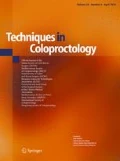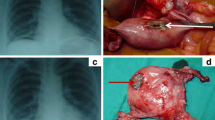Abstract
Rubber band ligation is a widely performed procedure in the outpatient setting for symptomatic haemorrhoids. This method is generally considered to be safe and easily performed. However, there have been reports of severe sepsis following interventions for haemorrhoids and the majority of patients had undergone rubber band ligation. We present a patient who had undergone elective rubber band ligation of haemorrhoids who presented with severe anal pain with difficulty in micturition. She deteriorated rapidly over a period of 3 days and succumbed to fulminant perineal sepsis.
Similar content being viewed by others
References
Steinburg DM, Liegois H, Alexander-Williams J (1975) Long term view of the results of rubber band ligation of hemorrhoids. Br J Surg 62:144–146
Bartizal J, Slosberg P (1977) An alternative to hemorrhoidectomy. Arch Surg 112:534–535
Bat L, Melzer E, Koler M et al (1993) Complications of rubber band ligation of symptomatic internal hemorrhoids. Dis Colon Rectum 36:287–290
Bayer I, Myslovaty B, Picovsky BM (1996) Rubber band ligation of hemorrhoids. Convenient and economic treatment. J Clin Gastroenterol 23:50–52
Spallanzani A, Ricchi E, Carriero A et al (1997) Rubber band ligation of hemorrhoids. Our experience. Minerva Chir 52:1047–1051
Wechter DG, Luna GK (1987) An unusual complication of rubber band ligation of haemorrhoids. Dis Colon Rectum 30:137–140
McCloud JM, Jameson JS, Scott AN (2006) Life-threatening sepsis following treatment for haemorrhoids: a systematic review. Colorectal Dis 8:748–755
Simonart T, Simonart JM, Derdelinckx I et al (2001) Value of standard laboratory tests for the early recognition of group A beta-hemolytic streptococcal necrotizing fasciitis. Clin Infect Dis 32:E9–E12
Wall DB, de Virgilio C, Black S, Klein SR (2000) Objective criteria may assist in distinguishing necrotizing fasciitis from non-necrotizing soft tissue infection. Am J Surg 179:17–21
McMahon J, Lowe T, Koppel DA (2003) Necrotizing soft tissue infections of the head and neck: case reports and literature review. Oral Surg Oral Med Oral Path Oral Radiol Endod 95:30–37
Elliott D, Kufera JA, Myers RA (2000) The microbiology of necrotizing soft tissue infections. Am J Surg 179:361–366
Author information
Authors and Affiliations
Corresponding author
Rights and permissions
About this article
Cite this article
Sim, H.L., Tan, K.Y., Poon, P.L. et al. Life-threatening perineal sepsis after rubber band ligation of haemorrhoids. Tech Coloproctol 13, 161–164 (2009). https://doi.org/10.1007/s10151-008-0435-5
Received:
Accepted:
Published:
Issue Date:
DOI: https://doi.org/10.1007/s10151-008-0435-5




